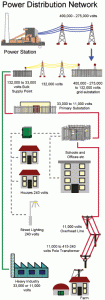The current world leader in solar power generation is Germany. Two years ago the solar power plants were recorded as generating over 20 gigawatts of electric power per hour. Last year that number increased to nearly 24 gigawatts. To put this in perspective, it would take nearly 20 nuclear power plants at maximum output to equal this amount of power generation. Germany is in the process of replacing nuclear power plants with renewable sources of energy including solar power. This is not without controversy, however, since the photovoltaic cells required in these plants are currently much more expensive than the materials needed for more traditional power generating plants. Germany has placed itself in the global spotlight by directly scoffing critics that say solar power cannot produce enough electricity to meet the needs of an entire country. While there is no plan to generate all of Germany’s electricity needs through solar power, they are certainly generating a significant amount. Interestingly enough, there are some critics that say too much solar power generation could flood the grid and cause storage problems for the country.
Running a distant second behind Germany is Spain. An example of the size of these solar power plants can be seen in the side-by-side arrays located at the solar power plant in Seville. The smaller array has 624 mirrors that focus sunlight toward a 40 story tower. The heat from the focused sunlight is used to convert water into steam, which turns a turbine that feeds a generator and makes electricity. The larger array has 1255 of these mirrors. The goal for the site was to power 180,000 homes with the electricity generated from these two arrays by the end of 2013. Similar to the problems Germany is seeing, it is currently more expensive to generate power in this method than the more traditional methods of coal-burning, natural gas and nuclear power. The budding industry is confident that as the technology continues to improve the cost will continue to drop.
The country that generates the third largest amount of electricity from solar power is Japan. Not surprisingly, Japan has taken huge and speedy steps away from nuclear power generation after the Fukushima disaster in 2011. Accomplishments in terrestrial solar power generation aside, one Japanese company hopes to construct a solar power generating plant on the moon. Even though construction of the megalithic project is not scheduled for another twenty years, it is still garnering quite a bit of attention. Two immediate advantages to having solar power plants that are outside the Earth is that they can generate power continually without any interference or other complications from the atmosphere. The proposal is to use robots to mine material from the lunar surface to build mirrors which will line the Moon’s equator. The energy collected at the moon will be beamed back to the Earth in the form of microwaves and collected at various stations in the Earth’s oceans. A lofty plan indeed, but not entirely outside the realm of possibility.
The last country to make the list is the number four producer of electricity from solar power. This is the United States of America. Currently there are several solar projects in either the developmental or planning stages across the United States. Some of the states that are planning these projects are Arizona, California, and Colorado. These projects are each estimated to supply 100,000 homes with electricity. Unfortunately, just like in Spain and Germany, the cost associated with solar power is higher than desired. Research into photovoltaic cells is actively being examined by the United States government, not to mention several other institutions including the Massachusetts Institute of Technology. Perhaps this is where the United States can contribute to the global move toward solar powered energy
Source:
http://1bog.org/blog/top-10-countries-using-solar-power/
http://www.reuters.com/article/2012/05/26/us-climate-germany-solar-idUSBRE84P0FI20120526
http://www.amusingplanet.com/2013/08/the-solar-power-towers-of-seville-spain.html
http://energy.gov/articles/5-super-sized-solar-projects-transforming-clean-energy-landscape







